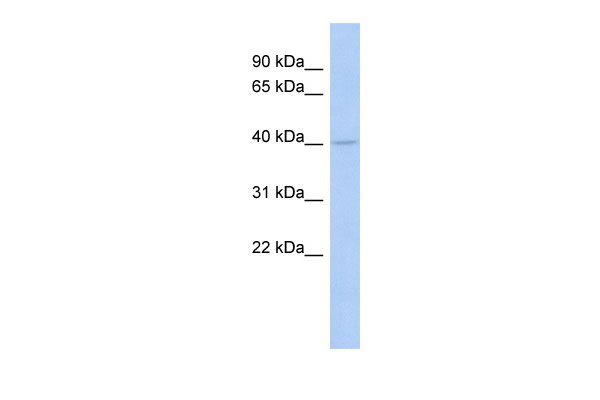COQ2 antibody - middle region
Rabbit Polyclonal Antibody
- 产品详情
- 实验流程
Application
| WB |
|---|---|
| Primary Accession | Q96H96 |
| Other Accession | NM_015697, NP_056512 |
| Reactivity | Human, Mouse, Rat, Rabbit, Zebrafish, Pig, Goat, Dog, Horse, Yeast |
| Predicted | Human, Pig, Dog |
| Host | Rabbit |
| Clonality | Polyclonal |
| Calculated MW | 40475 Da |
| Gene ID | 27235 |
|---|---|
| Alias Symbol | CL640, FLJ26072 |
| Other Names | 4-hydroxybenzoate polyprenyltransferase, mitochondrial, 2.5.1.39, COQ2 homolog, hCOQ2, Para-hydroxybenzoate--polyprenyltransferase, PHB:polyprenyltransferase, COQ2, CL640 |
| Format | Liquid. Purified antibody supplied in 1x PBS buffer with 0.09% (w/v) sodium azide and 2% sucrose. |
| Reconstitution & Storage | Add 50 ul of distilled water. Final anti-COQ2 antibody concentration is 1 mg/ml in PBS buffer with 2% sucrose. For longer periods of storage, store at 20°C. Avoid repeat freeze-thaw cycles. |
| Precautions | COQ2 antibody - middle region is for research use only and not for use in diagnostic or therapeutic procedures. |
| Name | COQ2 {ECO:0000255|HAMAP-Rule:MF_03189, ECO:0000303|PubMed:15153069} |
|---|---|
| Function | Mediates the second step in the final reaction sequence of coenzyme Q (CoQ) biosynthesis (PubMed:15153069, PubMed:16400613, PubMed:17374725, PubMed:20526342). Catalyzes the prenylation of para- hydroxybenzoate (PHB) with an all-trans polyprenyl donor (such as all- trans-decaprenyl diphosphate) (PubMed:15153069, PubMed:16400613, PubMed:17374725, PubMed:20526342). The length of the polyprenyl side chain varies depending on the species, in humans, the side chain is comprised of 10 isoprenyls (decaprenyl) producing CoQ10 (also known as ubiquinone), whereas rodents predominantly generate CoQ9 (PubMed:15153069, PubMed:16400613). However, this specificity is not complete, human tissues have low amounts of CoQ9 and rodent organs contain some CoQ10 (PubMed:15153069). Plays a central role in the biosynthesis of CoQ10 (PubMed:15153069, PubMed:16400613, PubMed:17374725). CoQ10 is a vital molecule that transports electrons from mitochondrial respiratory chain complexes (PubMed:16400613, PubMed:17374725, PubMed:27493029). CoQs also function as cofactors for uncoupling protein and play a role as regulators of the extracellularly-induced ceramide-dependent apoptotic pathway (PubMed:16400613, PubMed:17374725). Regulates mitochondrial permeability transition pore (mPTP) opening and ROS production (pivotal events in cell death) in a tissue specific manner (By similarity). |
| Cellular Location | Mitochondrion inner membrane {ECO:0000255|HAMAP- Rule:MF_03189, ECO:0000269|PubMed:27493029}; Multi-pass membrane protein {ECO:0000255|HAMAP-Rule:MF_03189}; Matrix side {ECO:0000255|HAMAP-Rule:MF_03189} |
| Tissue Location | Widely expressed. Present in all of the tissues tested. Expressed at higher level in skeletal muscle, adrenal glands and the heart. |
Research Areas
For Research Use Only. Not For Use In Diagnostic Procedures.
Application Protocols
Provided below are standard protocols that you may find useful for product applications.
REFERENCES
Brown,M.A.,(2007)J.Am.Soc.Nephrol.18(10),2773-2780ReconstitutionandStorage:Forshorttermuse,storeat2-8Cupto1week.Forlongtermstorage,storeat-20Cinsmallaliquotstopreventfreeze-thawcycles.
终于等到您。ABCEPTA(百远生物)抗体产品。
点击下方“我要评价 ”按钮提交您的反馈信息,您的反馈和评价是我们最宝贵的财富之一,
我们将在1-3个工作日内处理您的反馈信息。
如有疑问,联系:0512-88856768 tech-china@abcepta.com.























 癌症的基本特征包括细胞增殖、血管生成、迁移、凋亡逃避机制和细胞永生等。找到癌症发生过程中这些通路的关键标记物和对应的抗体用于检测至关重要。
癌症的基本特征包括细胞增殖、血管生成、迁移、凋亡逃避机制和细胞永生等。找到癌症发生过程中这些通路的关键标记物和对应的抗体用于检测至关重要。 为您推荐一个泛素化位点预测神器——泛素化分析工具,可以为您的蛋白的泛素化位点作出预测和评分。
为您推荐一个泛素化位点预测神器——泛素化分析工具,可以为您的蛋白的泛素化位点作出预测和评分。 细胞自噬受体图形绘图工具为你的蛋白的细胞受体结合位点作出预测和评分,识别结合到自噬通路中的蛋白是非常重要的,便于让我们理解自噬在正常生理、病理过程中的作用,如发育、细胞分化、神经退化性疾病、压力条件下、感染和癌症。
细胞自噬受体图形绘图工具为你的蛋白的细胞受体结合位点作出预测和评分,识别结合到自噬通路中的蛋白是非常重要的,便于让我们理解自噬在正常生理、病理过程中的作用,如发育、细胞分化、神经退化性疾病、压力条件下、感染和癌症。






